|
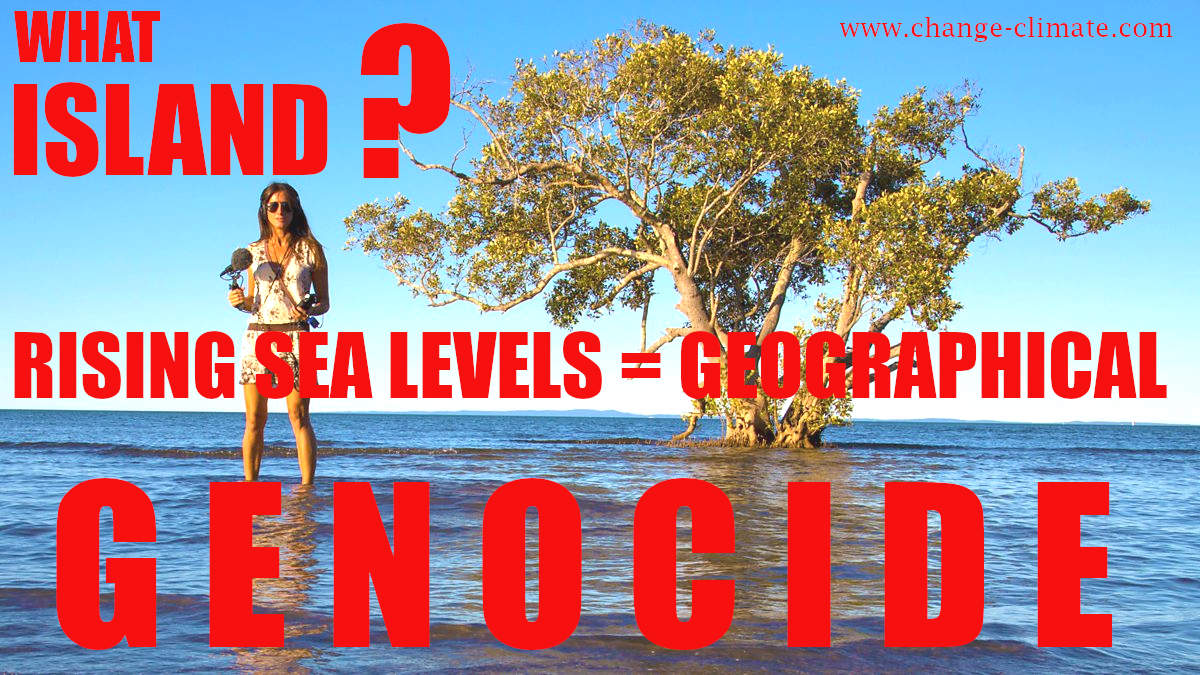
NATURE
GEOSCIENCE 2015
Sea level eventually could rise by at least 11 feet for residents living in the Northern Hemisphere because of a shrinking glacier in the Antarctic, a new science paper revealed this week.
An international team of scientists from the United States, Australia, Britain, and
France found that the Totten Glacier of East Antarctica — the largest and most rapidly thinning glacier in the region — is shrinking because of warm ocean water developing beneath it. The process could have “global consequences,” they wrote
in Nature Geoscience. Quote: “If thinning trends continue, a larger water body over the trough could potentially allow more warm water into the cavity, which may, eventually, lead to destabilization of the low-lying
region.”
Scientists already were aware of disappearing ice in West Antarctica. Through recent flight observations, though, they also found the same event happening in East
Antarctica. Until now, there was no indication the previously known rapid thinning of the glacier could affect coastal ice — by at least 11 feet, according to researchers at the University of Texas at Austin.
Much of the Totten Glacier’s basin lies below sea level. The airplane the scientists used was equipped with
radar that measures ice several miles thick,
lasers to gauge the shape of the ice surface, and equipment that senses the
gravity of the Earth.
Although the damaging impact of climate change is predicted to worsen in the coming century, its extreme effects are already being felt on every continent and across the world’s oceans, a
United Nations assessment revealed last year. The average combined land and ocean temperatures last October were the highest on record, and the global threat will increase if leaders don’t rein in the release of greenhouse gases into the atmosphere.
In the first major study from the UN since 2007, the Intergovernmental Panel on
Climate Change last March found that the increasing threat of climate change will continue to grow if residents don’t bring greenhouse gas emissions under control. The global threat will continue to worsen, the report said, if leaders don’t rein in the release of greenhouse gases into the atmosphere.
A major U.N. conference on climate change is scheduled to be held this year in
Paris.
In November 2014, Barack
Obama and Chinese President Xi Jinping announced a climate deal to reduce carbon emissions and tackle the growing crisis of global climate change. The pact includes a first-ever commitment by the Asian country to stop its emissions from increasing entirely after 2030.
J. S. Greenbaum, D. D. Blankenship, D. A. Young, T. G. Richter, J. L. Roberts, A. R. A. Aitken,
B. Legresy, D. M. Schroeder, R. C. Warner, T. D. van Ommen & M. J. Siegert
Nature Geoscience 8, 294–298 (2015)
doi:10.1038/ngeo2388 Received 12 December 2014 - Accepted 09 February 2015 - Published online 16 March 2015
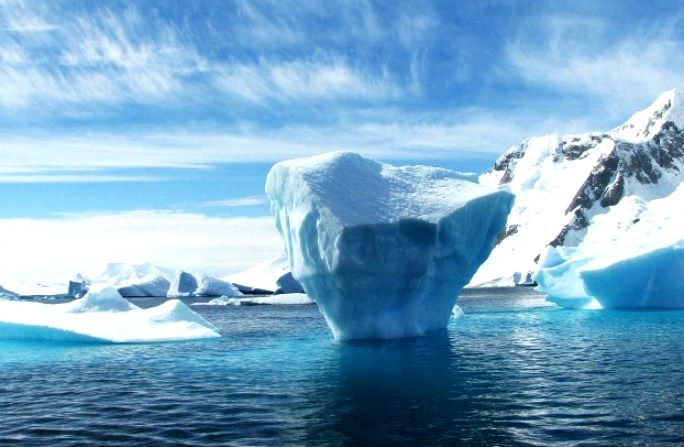
The Antarctic shelf seas are a climatically and ecologically important region, and are at present receiving increasing amounts of freshwater from the melting of the Antarctic Ice Sheet and its fringing ice shelves primarily around the Antarctic Peninsula and the
Amudsen
Sea. In response, the surface ocean salinity in this region has declined in past decades. The team concluded that accelerating discharge from the Antarctic Ice Sheet has had a pronounced and widespread impact on the adjacent subpolar seas over the past two decades.
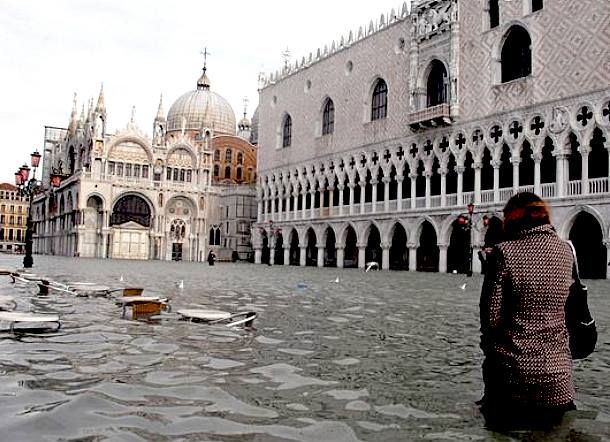
Over the past century, the burning of fossil fuels and other human and natural activities has released enormous amounts of heat-trapping gases into the atmosphere. These emissions have caused the Earth's surface temperature to rise, and the oceans absorb about 80 percent of this additional heat.
The rise in sea levels is linked to three primary factors, all induced by this ongoing global climate change:
Thermal expansion: When water heats up, it expands. About half of the past century's rise in sea level is attributable to warmer oceans simply occupying more space.
Melting of glaciers and polar ice caps: Large ice formations, like glaciers and the polar ice caps, naturally melt back a bit each summer. But in the winter, snows, made primarily from evaporated seawater, are generally sufficient to balance out the melting. Recently, though, persistently higher temperatures caused by global warming have led to greater-than-average summer melting as well as diminished snowfall due to later winters and earlier springs. This imbalance results in a significant net gain in runoff versus evaporation for the ocean, causing sea levels to rise.
Ice loss from Greenland and West Antarctica: As with glaciers and the ice caps, increased heat is causing the massive ice sheets that cover Greenland and Antarctica to melt at an accelerated pace. Scientists also believe meltwater from above and seawater from below is seeping beneath Greenland's and West Antarctica's ice sheets, effectively lubricating ice streams and causing them to move more quickly into the sea. Moreover, higher sea temperatures are causing the massive ice shelves that extend out from
Antarctica to melt from below, weaken, and break
off.
THE
GUARDIAN SEA LEVEL RISE 30 Oct 2014
Sea level rise is half due to melting ice and half due to ocean warming, including 13% from the deepest oceans, a new paper has found.
There have been a number of studies recently on ocean warming and sea-level rise. Collectively, they are helping scientists unite around an emerging understanding of climate change and its impact on the Earth.
Most recently, a study by scientists Sarah Purkey, Gregory Johnson, and Don Chambers was published. This team was responsible for a 2010 paper that was groundbreaking in that it quantified very deep (abyssal) sea warming. This latest paper is, in some respects, a continuation of that work.
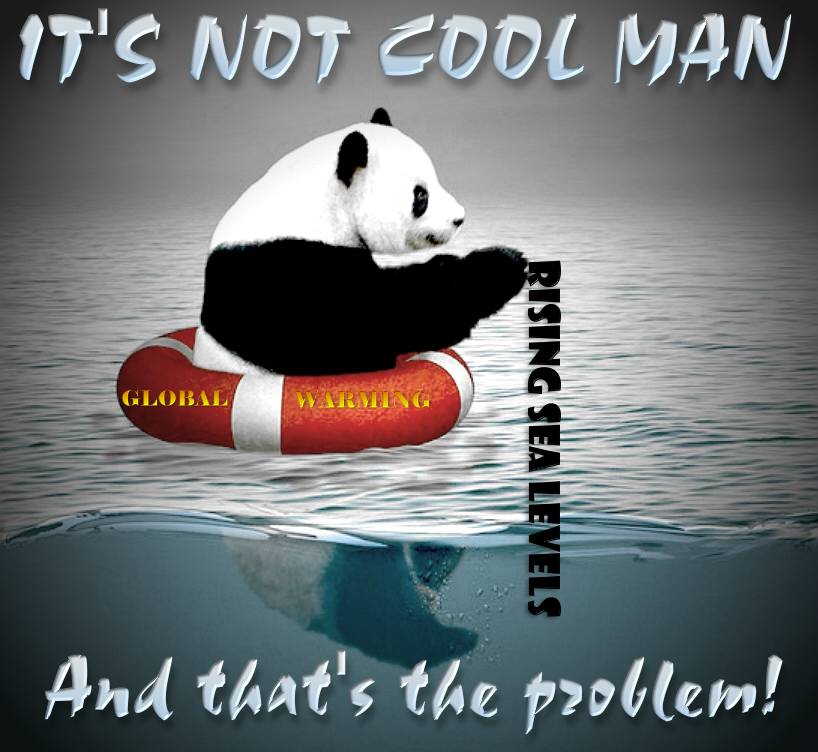
GLOBAL
WARMING - This amusing panda poster was inspired by the work of Victor van Gaasbeek.
Victor is a designer and illustrator from the Netherlands. He studied at the Grafisch Lyceum Rotterdam where he completed the Graphic Design Master Class. After that he enrolled at the Willem de Kooning Art Academy where he completed his Bachelor of Design whilst working for different design agency's.
Cool art Victor.
The researchers
recognized that changes to sea levels are mainly caused by thermal expansion of ocean waters as they heat, changes to the saltiness of water, and an increase in ocean waters as ice melts and flows into the sea. The total annual sea level rise is about 3mm per year – the question is, how much of that is from expansion and how much is from melting?
The researchers used a few tools to answer this question. One tool was ocean bottom pressure measurements. If you can measure changes to ocean pressure, you can deduce how much water is in the ocean. Another tool is through an inventory approach. This inventory method quantifies how much glaciers retreat, polar ice melts, and changes to water storage on land. The paper reports that both methods agree with each other. They conclude that increased water in the oceans is causing between 1.5–1.8 mm per year of sea level rise, depending, in part, on which years are under consideration.
The authors don’t just consider the ocean as a whole. They break the ocean regions into seven different sections because the change to ocean levels is not uniform. In some regions, waters are rising quickly, in others, the rise is much slower or zero. One reason for regional variability is that the Earth’s gravity is changing.
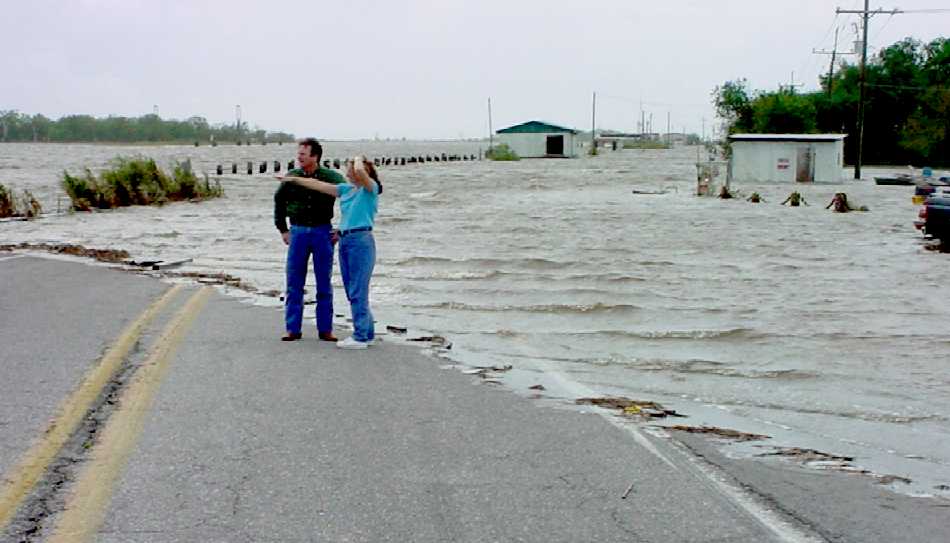
Imagine that this in your street and you'd soon start complaining that
today's politicians are pussies. We only really jump when something catastrophic
happens to us. If it is happening to someone else, or animals in far off
places that we cannot see - we do nothing.
For instance, there is so much ice in Greenland and Antarctica that is melting and flowing into the ocean, the mass of these two regions is being reduced; therefore, the pull of gravity toward Greenland and Antarctica is changing. As a result, we expect water levels near Greenland and Antarctica may actually fall as those
ice sheets melt.
But, ocean levels elsewhere, particularly US coastlines, will rise more than average because of this same effect. I have a paper in press with Ted Scambos on this very topic that should be published in a few weeks.
Another reason sea level rise isn’t uniform is that there are local changes to heat and salt which can increase or decrease water density in certain regions, causing local changes to sea level. A third reason is that changes to wind patterns can slosh water around, causing it to build up in one area, fall in another.
In each of the seven ocean regions, the researchers collected temperature and salt measurements at carefully distributed sections. These measurements allowed them to calculate how much of the ocean rise is due to heat/salt effects. They compared the expected sea level rise to actual
satellite measurements. The difference between expansion sea level rise and actual sea level rise is the contribution by melt water which flowed into the ocean. This method they call the residual measurement.
Then, they collected measurements from special satellites (GRACE) which measure local fluctuations in ocean mass. They compared the GRACE results with the residual measurement. It turns out they were in near perfect agreement; 1.5 mm per year of sea level rise is from added mass to the oceans. The rest is from expansion. Not only did the two methods agree, but they agreed region by region. They showed, for instance, that the South Atlantic and the South Indian/Atlantic Oceans are rising very rapidly. The North Pacific, South Pacific, and
Indian Oceans are rising modestly. The southern
Pacific is falling modestly and the North
Atlantic is basically constant.
Next, they calculated the relative sea level rise for waters from the surface down to different depths (300, 1,000, 2,000, 3,000, 4,000, and
6,000m to determine which layers make the largest contributions to sea level rise. The authors report that the deeper we go into the ocean, the less heating has occurred (this is expected and well known). Interestingly, they find that every water layer, even the deepest waters, have contributed some to sea level rise. They also report that the sea level rise contribution from the layers 300-2,000 meters is much more than previously reported.

We
wonder if Channing Tatum and Jamie Foxx will be up for a wild and wet
adventure paddling about Washington to rescue the State - too late. On its first weekend in the U.S., the film
White House Down" disappointed Sony
Pictures, coming in at number 4 at the box office. It earned $24,852,258, slightly ahead of Man of Steel, but less than
the similarly themed "Olympus Has Fallen" ($30.4 M). On its third weekend, the film made $20.7
million. The film grossed $73,103,784 in the United
States, plus $132,262,953 internationally for a combined gross of
$205,366,737. In October 2013, Sony announced it lost $197 million for June, July, and August 2013, and largely blamed "the box office flop of the movie White House Down as a key reason for the weakness".
Here at BMS, we enjoyed the movie immensely, mind you, we also enjoyed Olympus
Has Fallen. They both hit different spots, despite identical themes.
The casting was superb on both movies and so was the acting and direction,
leaving us to suppose that there is more to box office success than making
a really good movie.
Watch out for the spoof sequel: "Olympus Is Floating." Making us
wonder if Gerard Butler and Aaron Eckhart might be involved?
DR
JOHNSON SUMMARIZED THEIR RESULTS:
We find a small but measurable contribution from deep-sea warming to the global sea level budget (and hence global energy budget) from 1996–2006. The ocean warming is estimated directly from highly accurate, full-depth, oceanographic temperature data. The magnitude of the deep warming contribution to sea level below 2,000 m is about 13% of the total contribution of the mass trend below 2,000 m for that same time period.
I asked how this paper agrees or disagrees with a recent paper that reportedly showed the deepest ocean waters are not heating. He replied that the two studies actually agree with each other. They both show that the deepest ocean waters are likely contributing only a small fraction to the overall ocean energy/water rise. On the other hand, the uncertainty is largely because the deepest waters just don’t have a history of sufficient measurements to close the uncertainty range. He also stressed the importance of a proposed fleet of deep-water measuring devices (Deep Argo).
It is sometimes said that
“global warming” is really “ocean warming”. Given the importance the oceans have on our past and future climate, you can be sure scientists around the world are working to better understand how much heat is going into the oceans, where the heat is going, and what will happen in the future. The recent publications are helping us close the uncertainty range and improve our knowledge. This is what progress looks like.
ISLAND
NATIONS UNDER THREAT OF FLOODING FROM CLIMATE CHANGE - A TO Z
1. Cabo
Verde, Republic of
2. Carteret
Islands
3. Fiji,
Republic of
4. Ireland
5. Hawaii
6. Japan
7. Kiribati
8. Maldives
9. Marshall
Islands, Republic of the
10. Micronesia, Federated
States of
11. Palau
12. Sarichef
Island
13. Seychelles
14. Solomon
Islands
15. Tangier
Island
16. Torres
Strait Islands
17. Tuvalu
18. United
Kingdom
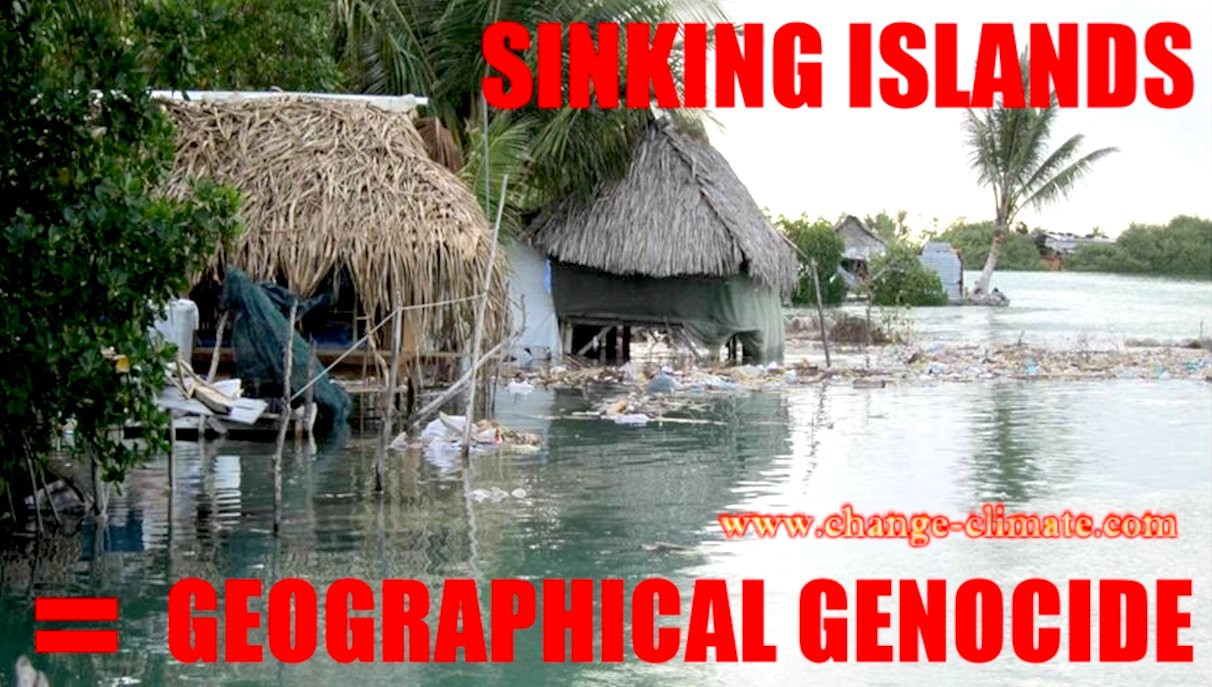
ACIDIFICATION
- ADRIATIC - ARCTIC
- ATLANTIC - BALTIC
- BERING - CARIBBEAN
- CORAL - EAST
CHINA
ENGLISH
CH - GOC - GULF MEXICO - INDIAN
- MEDITERRANEAN - NORTH
SEA - PACIFIC - PERSIAN
GULF
SEA JAPAN
- STH
CHINA - PLASTIC
- PLANKTON - PLASTIC
OCEANS - SEA
LEVEL RISE

PATENT
PENDING NO LONGER - Adapted versions
of the solar powered Bluefish ZEWT would make an ideal fleet to clean up large areas of oceans,
such as the plastic gyre garbage patches that the UN
are concerned about. Codenamed SeaVax, a fleet of robots ships that are
designed to tackle ocean waste en masse, could make a significant impact on
the five ocean gyres that are now the biggest rubbish tips in the world.
Sad, but true. Humans
are killing the planet and themselves for a short but convenient
lifestyle. The idea was first proposed in 2015, displayed in 2016 and
shelved in 2020 after five long years of development and lobbying. The
European Union's 'Commission' said the concept and technology was not new.
What a bunch of dimwits. Even in 2021, going into 2022, there is nothing
like it developed or afloat anywhere in the world. Well done Horizon
2020! With assessors like that, we are up
shit creek without a paddle, the proverbial. You may have noticed how
ineffectual the Commission is in cleaning up ocean
plastic. Yes, it is getting dirtier, not cleaner. Even the United
Nations is powerless to stop it, and as for the G20
industrialists, well where else would they dump all their waste free of
charge, if not in the oceans.
The
patent was not filed, though drafted, because the fees were too high and
renewals would have sunk the not for profit concern, who was keen to
disseminate the information. It's high time we had a system for genuinely Green
Patents, to allow social enterprises such as the above and multi-purpose
hydrogen service stations, a better chance. In addition, 20 years is far too
short a lifespan, for technology that climate
deniers are doing their best to hide, in favour of fossil fuels like coal.
LINKS
& REFERENCE
The
Guardian environment
climate-consensus-new-research-quantifies-sea-level-rise
http://www.theguardian.com/environment/climate-consensus-97-per-cent/2014/oct/30/new-research-quantifies-sea-level-rise
Wikipedia
Marine_pollution National
Geographic critical-issues-sea-level-rise Victor
Vangaasbeek Sony
Pictures White H ouse Down Twitter
Olympus movie Wikipedia
Olympus_Has_Fallen
Wikipedia
White_House_Down Science
ifl shrinking artic glacier http://www.nature.com/ngeo/journal/v8/n4/full/ngeo2388.html http://www.scienceifl.com/shrinking-artic-glacier.htm http://ocean.nationalgeographic.com/ocean/critical-issues-sea-level-rise/ http://www.victorvangaasbeek.com/ http://en.wikipedia.org/wiki/Marine_pollution
http://www.sonypictures.com/movies/whitehousedown/
https://twitter.com/olympusmovie
http://en.wikipedia.org/wiki/Olympus_Has_Fallen
http://en.wikipedia.org/wiki/White_House_Down
|




